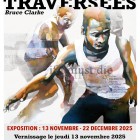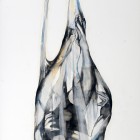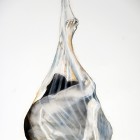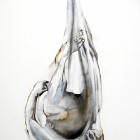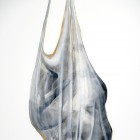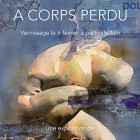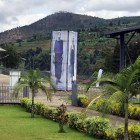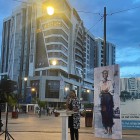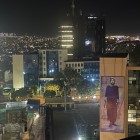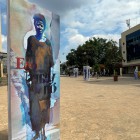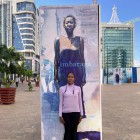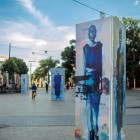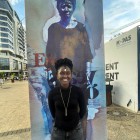
“It is a work of art, and not the newspapers of the time or the academic histories, which remind us more than seventy years after the event, that it actually took place, Guernica, the tragedy of the little Basque village. Now as earlier, the artwork, can bear witness in a blindly definitive way, there where other means are only futilely ephemeral news”.
(Jean Clair, The responsibility of the artist, p.19)
The necessity to represent
We might believe that from its origins, painting has been intimately linked to death, that it has always been attempting to domesticate the forces of evil and to bear witness to the possibilities of reconstruction. This is perhaps why Bruce Clarke felt the need to commit himself in the real world in his visual arts projects. Even if political commitment is different to what happens in the realm of artistic creation, it can nevertheless be brought to stage front, as if the need to “represent,” to re-present what cannot be easily perceived was suddenly urgent and primordial. Is not the primitive scene the same thing as the figurative scene? The need to represent becomes important in order to calm the violence of the unbearable or unconscious images embedded in the depths of memory.
“The main role I assign to my paintings is to establish a bridge towards the outside world, to pose questions, often without response in a teasing as well as a serious way, ingenuous and naïve at the same time. My paintings are only paintings, but I see them as markers, landmarks in my political engagements and activism, whether it be for South Africa, Rwanda or for Palestine etc. They are open windows, inviting those who look to come in. Once inside the idea is to widen the debate, discussion and reflection. That’s how my paintings take on a political dimension. Something can perhaps happen with them. I’m providing an opening for speech…
…It was around 1990 that I became involved in the Rwandese question. In part due to my Rwandese friends and different readings I began to understand that after thirty years of authoritarian and segregationist rule, punctuated from time to time by “genocidal acts”, the final solution was being prepared. After the genocide, the question of what art, what an artist could do in reconstruction was posed.”
(B.Clarke, Interview, August 2002).
It is obviously impossible to deal with all the examples in the History of Art which make reference to the problematic of art and memory. We will make do with quoting a few exemplary artists and their works.
The third of May 1808 by Francisco Goya, 1814
This painting is emblematic of the “horrors of wars” as is Guernica by Pablo Picasso. The two Spanish painters have each painted one side of a diptych placing their art at the summit of universal tragedy.
The Spanish war of independence (Napoleon’s troops entered into Spain in 1807) pushed Goya, to produce six years later, on a single canvas a sort of synthesis of the experiences he had lived through during the years of conflict. “Who can forget the hallucinating eyes of the man in the white shirt?” In front of the mound of earth and following the luminous diagonal on the naked ground, Goya stages the confrontation between the French troops reduced to faceless silhouettes and Spanish peasants. The lines of bayonets in the prolongation of the legs, transform the group into a killing machine. Facing them, the principal personage, in full light, opens his arms, hallucinated. At his feet, dead and dying people drenched in blood. Thus purified, the killing field as interpreted by Goya is more than a mere history scene of the Madrid insurrection; it speaks the universal language of blind oppression. This painting inspired Monet in his “Execution of Maximilian” (1867) and later Picasso in his “Massacre in Korea” (1951).
Guernica by Pablo Picasso, 1937
“I believe that when great artists have changed things in painting, their motives weren’t painting; they had such new things to say, such necessities, that they had to find new forms to say them, through necessity”
(Ernest Pignon-Ernest, “Live Poetically”, p. 49).
Another war, the 1936 Spanish civil war in the course of which Robert Capa immortalised the shooting of the Republican soldier in a photographic version of the Third of May by Goya. What was new with Guernica, an icon of the destructive tragedy of wars, is the appropriation by the artist of the media of the period (newspapers, photos, news reel film) that forms the real iconographic key to the work. In the spring of 1937 the entire Basque country fell to Franco’s forces and their German and Italian allies. Durango was annihilated, then Guernica, Bilbao, Santander. But it is Guernica which stayed in our collective memory.
The original sources of the painting, the starting point, are the news items, but news at distance, seen through the mediation of the evening papers. Picasso was in Paris. He was famous and rich, but still he was profoundly shaken by this war.
The 26th April 1937, the church bells in Guernica rang; the planes dropped their bombs and killed more than 1600 people. Four days later, Picasso who was frustrated in his Grand Augustin studio saw the photos and the headlines in Ce Soir – he immediately began to make the first sketches of what was to become his scream of desperation in the face of modern warfare. The 10th May, he started working his first ideas on the canvas. (There are seven preliminary versions photographed by Dora Maar) and on the 3rd of June the painting was finished. The 4th, it was hung in the Spanish Pavilion of the Universal Exhibition in Paris, where it was intended to be accompanied by a poem by Paul Eluard. The painting is dark, white, grey like the newspapers that told the story of the event to the man in the street who thus discovered the horror. What was new and invented by Picasso was the idea of working through the painting with images and printed texts from the media. In doing so, the visual novelty is directly linked to the need to find a new language. Guernica is black and grey like the newsreels and the press photos that are at different levels integral parts of the work.
Zoran Music''s drawings from Dachau, 1945
Zoran Music is a Slovenian painter, born in 1909 and deported to Dachau in 1944 because he refused to become an SS. After the liberation of the camps, he set up in Venice where he painted and began to free himself of the visions that he had of the concentration camps. His visions are powerful and directly experienced.
Close to Schiele, Kokoschka, but also to Goya, Zoran Music is the descendant of painters of the human body, suffering and pained. And it is armed with a pencil and brush that he was able to bear witness. He used precarious materials and supports, anything that he found: wrapping paper, administrative registers, some ink, ends of stolen crayons. The act of bearing witness and drawing kept the resistance going in him.
“I didn’t want to illustrate, make documents. I drew what could interest a painter. I didn’t feel like a journalist. There are visual things and there are things that one feels and that one can do eyes shut. You express yourself. Yes, it’s like an interior landscape.”
(Jean Clair, “Ordinary Barbarity”, Interview with Zoran Music, p. 137 and 146).
The Paris Commune and other in situ works by Ernest Pignon-Ernest, 1966
At first site, there seem to be many common points between the work of Bruce Clarke and E.P-E. for whom the most accomplished forms of commitment are the ones that put us back in our time, but above all take us outside galleries and studios, bringing us to the walls in the street.
“It was an intervention around the Paris Commune, the interaction between image, place and moment. For the Viet Nam war, I had begun to paint expressionist bodies, tense, torn, but it seemed more and more urgent to integrate everything which served as a source of information to us – press, telly, media in general – to visually take account of these objective facts.”
In this sense he developed the same principal as Picasso in Guernica which he explains in this way: “It’s a question of seizing hold of the real places like a palette: the time; the hundredth anniversary of the Bloody Week, the place: Charonne, Sacré-Coeur, for their poetic and dramatic potential It’s when we pasted images at night, on the steps of the metro, with emotion, memory enhanced by the night-time, clandestinely, that I felt that my work couldn’t just remained visual. I had to organise my images, to use the breaking steps, the volume of the staircase. I took into account the symbolic weight that the place bore, loading my images as they weighed on the place.
(Marcelin Pleynet, Ernest Pignon-Ernest, “Live Poetically”, p. 31-35)
Thus the question of placing the work in its space, the contextualisation, the stage management of the artwork is very important; but this is different for Bruce Clarke. Let us quote Etrnest Pignon-Ernest again:
“ I know that I can’t treat the subject correctly uniquely through drawing; much of its meaning comes from the place where it will be created. The specific qualities of the place, whether they be visual or symbolic, combined with its suggestiveness that provokes meaning. The drawing itself shouldn’t give the impression of a drawing simply exhibited in the street; it’s got to link in intimately with the wall, the ground, the street space – some of these elements will even become parts of the drawing itself”.
(Marcelin Pleynet, E.P-E., “Live Poetically”, p. 33, 76).
Text : Michèle Baj-Strobel



